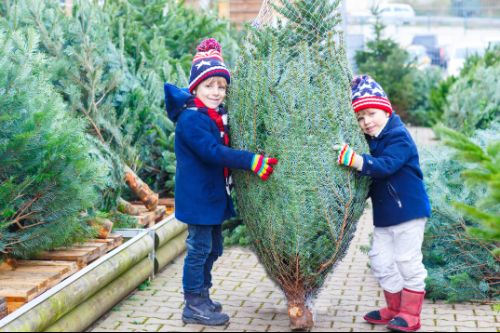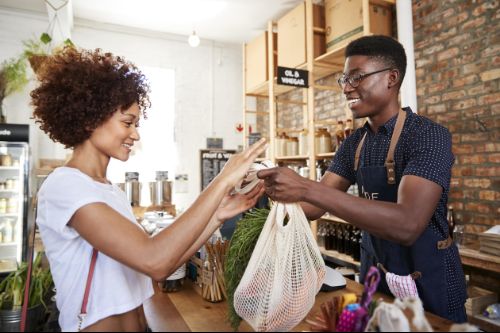It’s that thyme of year when Christmas lights brighten up our days (and nights), wrapping paper fills our closets, and our car trunks seemed to constantly be brimming with decorations, presents, and groceries.
It’s also when reducing food waste and living sustainability seems to fall lower on the list of things to do - when it should be higher than ever. 43% of food waste in the United States occurs at home - and during the holidays household waste increases more than 25% between Thanksgiving and New Year’s.
Reducing food waste and living more sustainably isn’t as difficult as it may sound. Making small changes in your lifestyle is a simple, yet effective way to live a more sustainable life. Less food waste overall means more food in the stomachs of the 44 million food insecure Americans, as well as a healthier ecosystem.
Here are 10 tree-mendously easy ways you can live sustainably this holiday season:
1. That’s a wrap!
Each year, about 2.3 million pounds of wrapping paper end up in landfills. Out of the 4.6 million pounds of wrapping paper produced annually, that means about half of the wrapping paper made each year is wasted.
Buying wrapping paper made by sustainable brands is a great way to combat this waste. Wrappily, a company that produces newsprint wrapping paper, sells products that can be recycled up to seven times. They make their wrapping paper out of recycled paper and lumber mill sawdust that would otherwise go to waste, so not only does it help the environment by being able to be recycled, unlike most wrapping papers, but it also is a product of recycling itself.
Wrapping paper from presents given to you or your loved ones can be reused as tissue paper for bagged presents, shredded into confetti for your New Year’s party, or used in DIY projects and crafts! Additionally, shredded wrapping paper can be used as packing material to keep fragile packages and decorations, such as ornaments and stars, safe. Don’t forget to also save any bags used for presents - they’re perfect for re-gifting!
2. Save your energy
Lighting up your house for the holidays is a fun and joyful way to celebrate the season's delights. However, it also greatly impacts energy use and carbon dioxide emissions.
 It’s estimated that each household, on average, will use 65 kWh of electricity to power their holiday lights throughout December. Accounting for the number of houses that will utilize holiday lights, it’s estimated that 3.5 billion kWh of electricity will be used to power holiday lights across America in December. That’s equivalent to the annual energy usage of 350,000 homes.
It’s estimated that each household, on average, will use 65 kWh of electricity to power their holiday lights throughout December. Accounting for the number of houses that will utilize holiday lights, it’s estimated that 3.5 billion kWh of electricity will be used to power holiday lights across America in December. That’s equivalent to the annual energy usage of 350,000 homes.
Using these estimations, Arcadia believes that an additional 2 million tons of carbon dioxide will be emitted into the Earth's atmosphere. However, if only LED lights are used as holiday lights nationwide, this number is reduced to a quarter of the amount. LED lights use about 85% less energy than traditional lights.
Another easy way to reduce energy use is to put your Christmas lights on a timer that only turns them on at certain times. There are also new forms of decorations such as lasers that use 0.005 watts per hour, as well as preprogrammed lights that twinkle and only use certain bulbs at different times to cut down on energy use.
 3. Feelin’ Pine
3. Feelin’ Pine
For many families, Christmas trees are a must-have for celebrating during the holiday season. With that being said, there are ways to be more environmentally friendly options to this holiday staple.
One option is to rent your tree. After the holiday season, most people who buy real Christmas trees throw theirs out on the curb. Rented trees are returned to companies who replant them to be rented out once more in the following years.
If you choose to buy your tree, they don’t have to be tossed out at the end of the season! The wood can be turned into mulch or firewood for cold winter days, and the leaves can be made into an air freshener or boiled into tea. Here are a few different ways you can repurpose your Christmas tree!
Fake Christmas trees are often believed to be a financially smarter and less messy option than real trees - however, fake trees are made out of plastic, so once they’re thrown out, they end up in a landfill. Even before throwing these pseudo-trees away, their shipping method produces carbon emissions. This has the opposite effect of regular trees that use photosynthesis to turn carbon dioxide into oxygen and should be factored into a consumer's decision when choosing their Christmas trees this upcoming December. According to One Tree Planted, a fake Christmas tree would have to be kept for no less than 10 years for it to have the same carbon impact as a real tree. This doesn’t include the environmental impact fake trees have as they break down in landfills, though.
Whichever type of tree you decide on, don’t forget to use LED lights in place of your other Christmas lights, and don’t forget to set them on a timer!
4. Give the Gift of Experience
Every year materialistic items are wrapped in boxes and covered in wrapping paper before they are given as gifts. It’s estimated by the that 125,000 tons of plastic packaging and 277,000 miles of wrapping paper are thrown away each holiday season. That is enough to go around the earth over ten times!
A good alternative to cut down on this waste is to give experiences as gifts. For example, for the sports fans in your life, you could buy tickets to a local baseball or football team. Concert tickets could be bought for artists on a tour that may be coming to your area in the upcoming weeks. Or a series of yoga classes or music lessons can be bought and presented as a gift. With more and more opportunities, giving experiences is a perfect gift for the holiday season. Bonus points if you ride a bike, public transit, and or a sleigh pulled by reindeer to get there!
5. Get Movin’ and Groovin’
Seeing all the Christmas lights and decorations is one of the best parts of the holiday season!
If you live in a neighborhood that loves to decorate for the holidays, opt to take a neighborhood stroll instead of driving from house to house. If you’re driving to neighborhoods with award-winning decor, park in a safe place on the side of the road and take in the sights on foot.
Make sure to dress warm, and don’t forget to grab a thermos of hot cocoa to share!
6. #ShopSmall
We know it’s incredibly easy to pile your Amazon cart full of gifts for loved ones, but shopping at small businesses is a great way to support your local community and live more sustainably.
 It’s estimated that buying from small businesses generates 3.5 times more wealth than shopping at national chains. Additionally, shopping at local businesses helps reduce your carbon footprint because, even if you have to drive a few miles to the stores, you’re eliminating the carbon footprint from delivery and packaging materials.
It’s estimated that buying from small businesses generates 3.5 times more wealth than shopping at national chains. Additionally, shopping at local businesses helps reduce your carbon footprint because, even if you have to drive a few miles to the stores, you’re eliminating the carbon footprint from delivery and packaging materials.
To further reduce your carbon footprint from shopping, carpool with your friends and family to the shops, and make sure to bring your own reusable shopping bags!
A few other reasons it’s better to #shopsmall include keeping money in your community, helping keep your neighbors employed, creating a sense of community, and keeping your local business thriving. Plus, when you buy in-store, you don’t have to worry about your packages being delayed!
7. Meet ‘The Plastics’
We don’t have to push this plastic in front of a bus to eliminate its impact, though (Mean Girl reference, anyone?).
Each holiday season, roughly 125,000 tons of plastic packaging is discarded. Where does it all go? 79% of plastic ends up in a landfill, and 12% is incinerated, releasing carbon dioxide into the atmosphere through combustion. This leaves a mere 9% of plastic that is actually recycled.
Instead of purchasing gifts with high amounts of plastic packaging, look for gifts like sustainably made candles, zero-waste gift boxes (like these from EarthHero), plants, books, kitchen supplies, and so many more!
8. Got milk? (and cookies too!)
Putting out milk and cookies for Santa is a favorite holiday tradition that everyone loves! They’re the perfect award for parents after a long night of wrapping presents and setting up for Christmas day - ahem, we mean for Santa after a long night of delivering presents.
If you’re not a huge fan of cookies and milk or have dietary restrictions, make sure to buy late night snacks you don’t mind eating! If you can’t drink regular milk, opt for almond or coconut milk, or choose to set out a glass of cold water - Santa needs to stay hydrated, after all! If cookies aren’t your thing, choose to set out a bowl of fruit or your favorite candy instead, and you can always turn the glass of milk into a favorite cocktail too.
9. Dreidel, dreidel, dreidel
During the celebration of Hanukkah, one of the favorite holiday-related songs to sing is “Dreidel, Dreidel, Dreidel”, in which it is explained that a dreidel is made out of clay, and when it is ready, all will play. However, many dreidels are made out of plastic. To cut down on plastic use during the holidays, use dreidels that are made out of clay and wood as opposed to their plastic counterparts.
10. (Environmentally sustainable) Candles are lit
During Hanukkah and Kwanzaa, candles are used for different holiday celebrations. Consider buying environmentally sustainable candles made from natural alternatives such as beeswax and soy, which are much more friendly to the environment. These Goodlight Chanukah candles are “clean burning and non-toxic”, and the company “contributes to sustainable palm farming”.
Simple steps can be taken every day to be more sustainable at home. Incorporating these tips into your life will not only save you money, but the earth too!
Want to learn more about recycling, and sustainability? Check out our blogs on composting, food waste, and Ways to be Sustainable this Fall. If you want to join the fight against hunger, consider becoming a monthly donor!

